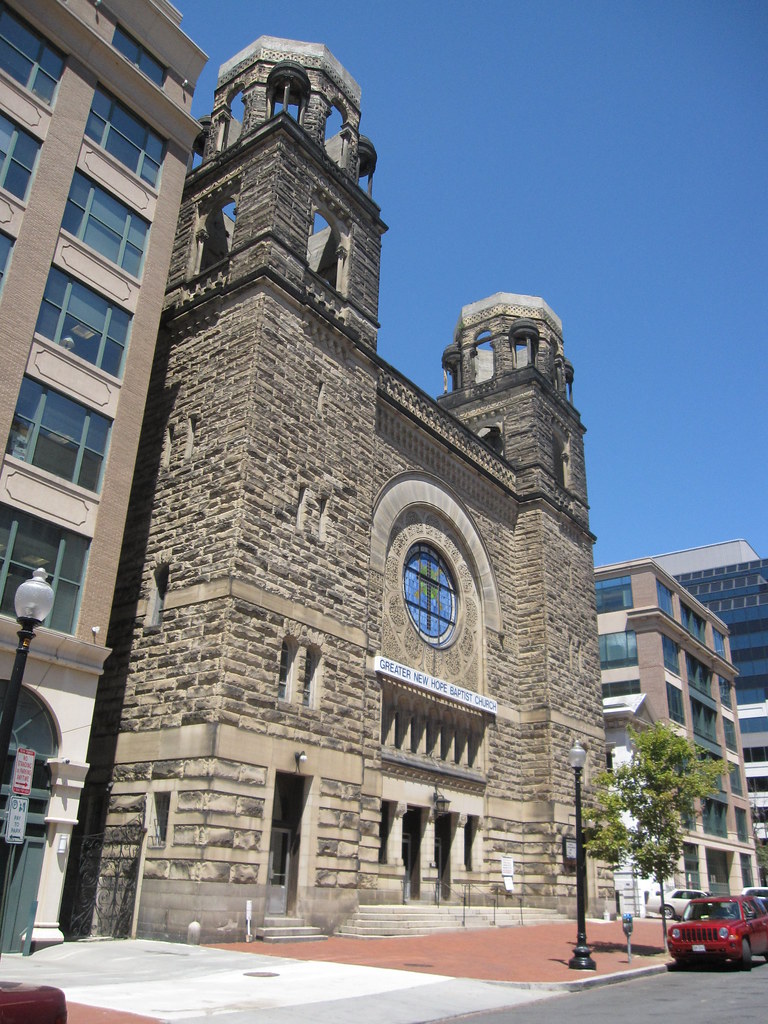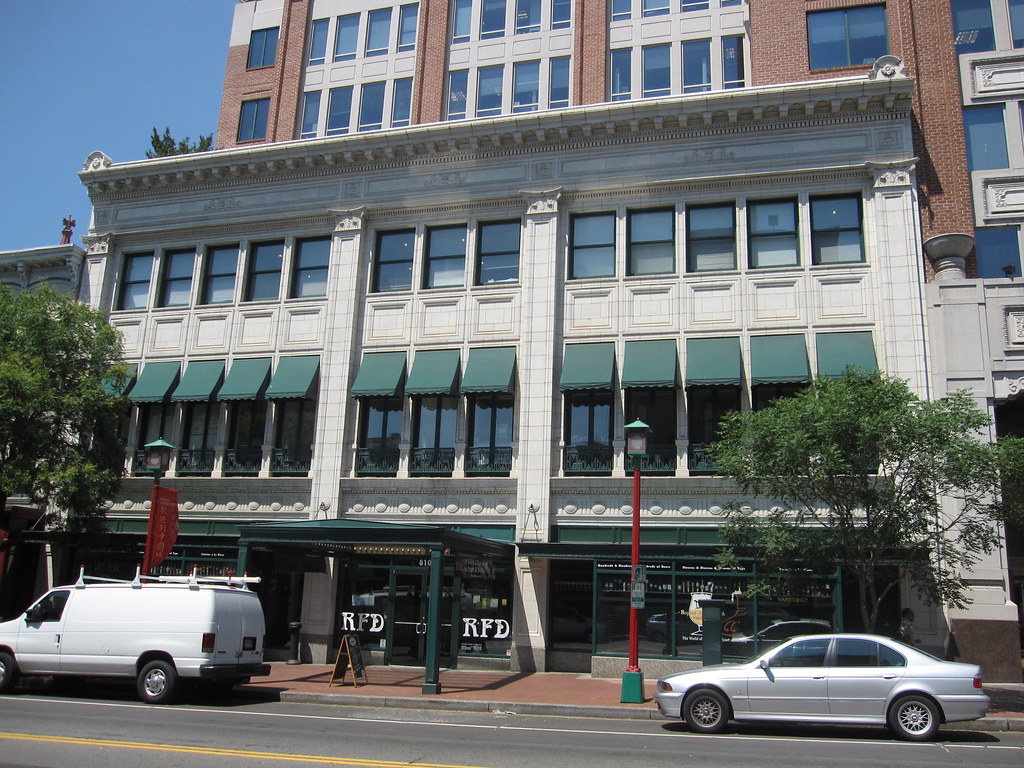One of the most elegant storefronts in Chinatown is the broad and richly ornamented terra cotta façade of the building at 810 7th Street, NW. This structure was once the pride and joy of Henry King, Jr. (1834-1897), one of Washington's most prominent retailers in the late 19th century.
Henry King was born in the spa town of Baden-Baden in western Germany. Because his father intended that he become a rabbi, young Henry received an excellent education, mastering six languages, according to a profile that appeared in
The Washington Post in 1925. While a student at the University of Heidelberg, he absorbed the revolutionary spirit of the times and decided in 1850, at just 16 years of age, to join a group of friends that were leaving for America. Landing at Baltimore, he soon found his way to Washington, where he got a job sweeping the floors of Moses Ring's clothing store on Pennsylvania Avenue. When he turned 21 in 1855, he proudly became a U.S. citizen.
In those days, much of the city's retail commerce took place along Pennsylvania Avenue, and there King learned the ins and outs of the retail clothing business. After a couple of successful years with Moses Ring, he opened his own Pennsylvania Avenue clothing store in 1859. He also met and in 1861 married Caroline Straus King (1842-1909), another young German immigrant. Caroline took a strong hand in helping run Henry’s store and developed a specialty of making fancy hats. The couple would have seven children—six sons and one daughter, the youngest. Presumably Henry planned to leave the store in Caroline's hands when, filled with patriotic fervor, he tried to enlist in the Union Army in 1861. His military career, however, never materialized; he was rejected because of a "muscular affliction" in his right arm.
King's store was very successful in the 1860s and 1870s. Newspaper articles would occasionally mention trips by either Henry or Caroline to acquire stocks of the most fashionable hats from New York or Paris. According to later articles, King sold hats to Mary Todd Lincoln (1818-1882) and Julia Grant (1826-1902) when they were in the White House, both ladies having an eye for fine clothing. President Grant sometimes accompanied his wife when she went shopping, and it was said that he would sit in the back of the store with Henry King smoking large black cigars while Caroline King helped Julia choose a hat.
The Henry King clothing store changed locations a number of times in the 1870s and then around 1878 finally settled at 814 7th Street, NW, where it remained for more than half a century. The business was christened "King's Palace," and became a lasting Washington retail fixture. Starting with a simple storefront on 7th Street, King gradually expanded both along 7th and to the rear; by 1882, the store extended all the way through the block to 8th Street. The
Post reported that year that King had installed “a row of handsome French mirrors” to assist women trying on hats, and in the evenings “one hundred and twenty-five brilliant gas jets flood the store with light.” For the fall season’s “opening,” King offered everyone who entered the store “an elegant, fine and expensive souvenir, while an additional souvenir will be presented to each purchaser.”
If you want to buy goods, and wish to save your money, and desire to be treated well, and wish to find a choice and largest stock to select from, you are in duty bound to go to the Great Headquarters, the largest Millinery House, KING’S PALACE, 814 Seventh Street.
 |
| Logo from an 1891 advertisement. |
A full-page advertisement in
The Washington Herald in September 1890 advertised the "opening" for that fall, complete with "All the Latest Parisian Hats and Bonnets and all the Novelties in the Millinery Line." The ad went on to boast that, after "extensive improvements," King's Palace had "the largest First-Floor Business House and one of the handsomest show window fronts in this city... You can do all your shopping at KING'S PALACE without risking your life in elevators and without climbing any stairs, which makes shopping in out Mammoth Establishment a pleasure."
 |
| Source: The Washington Post, Sept. 10, 1898. |
Across the street from the rear of King’s Palace, on 8th Street, stood a church building that had been taken over by the Washington Hebrew Congregation in 1863. The Kings were members of this congregation, and Henry King became its president in the 1880s. At Caroline’s prodding, King began a campaign in the 1890s to raise money for a new and much-larger temple building. By 1897, funds had been secured and a competition was held to design the new building. The winning architects were Louis F. Stutz and Frank W. Pease, a well-known firm in Washington, according to the
Post. Stutz and Pease designed a unique, granite and limestone building meant to evoke the Holy Land. Its façade was "somewhat Byzantine in effect," the
Post observed, although it also reflected Romanesque Revival styling. It included two commanding 135-foot-tall towers. President William McKinley and his entire cabinet were on hand for the laying of the cornerstone of the new building in September 1897; unfortunately, Henry King was not there. He had died just one month earlier. The structure remained the home of the Washington Hebrew Congregation until 1954, when the congregation moved to a new building at Massachusetts Avenue and Macomb Street, NW. The Greater New Hope Baptist Church then purchased the building and has been using it ever since.
 |
| The Greater New Hope Baptist Church as it appears today. The original onion-shaped turrets were removed in the 1970s because they had deteriorated. |
Meanwhile King’s sons continued to operate King's Palace on 7th Street, expanding the business from its original emphasis on millinery to become a full-fledged, modern department store. A branch store opposite
Center Market on Pennsylvania Avenue had been in operation since the 1880s, but that store was closed in 1907 after expansion of the 7th Street store allowed all merchandise to be consolidated there.
In July 1914 a fire caused significant damage to the building, necessitating extensive rebuilding. The King brothers managed to keep parts of the store open while an entirely new façade—the one that remains there today—was built. Completed in November, the new façade received rave (and identical) reviews in the
Post and the
Herald:
The front is constructed of glistening white hollow tile. Four massive square columns, surmounted by a towering, deep cornice, give an effect of dignity and strength, which is pleasingly combined with ornate capitals and relief work. The whole result is one of remarkable richness.... A graceful wrought iron balcony extends across the entire front on the second-floor level, and will be utilized for a display of evergreens and perennial vines and flowers.... The show windows are the last word in modern construction, with copper frames and marble bases. Circassian walnut is employed for the window backgrounds in an artistic arrangement of columns and panels, and the hardwood parquet flooring is laid to match....
The alterations to the structure, costing $30,000, were designed by Frederick B. Pyle (1867-1934), an accomplished Washington architect who also designed several other landmark D.C. buildings, including the restrained, neoclassical "modern" half of the
Woodward & Lothrop building as well as the 1903 Hecht Company building at 7th and F Streets NW. Like King's Palace, the Hecht Company building makes rich use of decorative terra cotta, which had become a popular materiel for decorating steel-frame commercial buildings since the late 19th century.
King's Palace continued to do business until then-owner Mortimer King left for Indiana in the mid 1930s. (
See comment below.) The ornate storefront was taken over by the G.C. Murphy Company, which specialized in very inexpensive merchandise and did well during the Depression. Murphy's stayed in the building through the 1960s and was followed by a variety of other tenants as the neighborhood went into decline after 1968. In 1977, a blue jeans outlet called The General Store moved in. Then around 1990, the north half of the block, including the old King's Palace store, was redeveloped into a large office building, and the façade of the old store was preserved, with new construction set back behind it. A Brazilian
churrascaria called Coco Loco moved into the redeveloped space in 1994, marking one of the earliest indications that this neighborhood would develop into the trendy entertainment district that it is today.
Kim Williams, D.C. Historic Preservation Office, provided valuable assistance for this article.










Check out the Jewish Historical Society's related post: http://jhsgw.org/collections/objectofthemonth/2011-feb.php
ReplyDeleteAlways look forward to your postings. I often walk up 7th Street and will now know to look for King's Palace. Thanks.
ReplyDelete"King's Palace continued to do business until it disappeared in the mid 1930s. One presumes it was a victim of the Great Depression."
ReplyDeleteI can be more specific. In 1934 my great-grand-aunt Thelma went to Washington D.C. to visit her aunt Sally who was a clerk at King's Palace. Sally casually introduced Thelma to her boss, the current owner Mortimer King. Thelma and Mortimer were married three months later. Mortimer had had enough of big city life and longed for country living. So he closed King's Palace and went back with Thelma to her small hometown in southern Indiana. Mortimer opened two manufacturing companies there which are still in business today owned by his grandchildren.
Thank you very much for filling in this crucial bit of information! It adds quite a bit to the story. I've edited the blog article as a result.
Delete